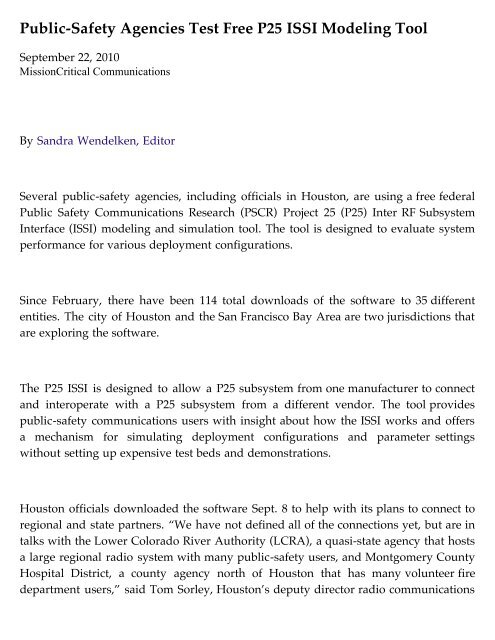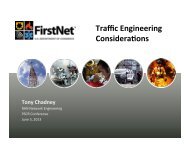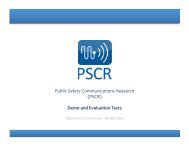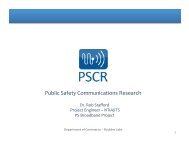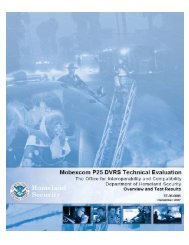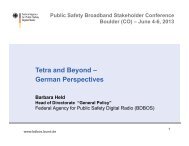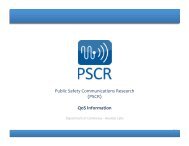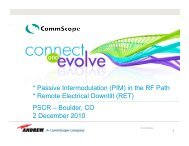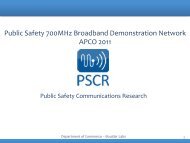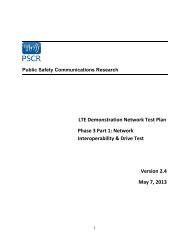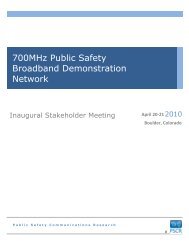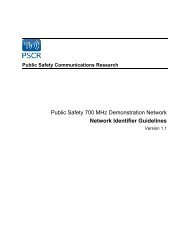Public-Safety Agencies Test Free P25 ISSI Modeling Tool - PSCR
Public-Safety Agencies Test Free P25 ISSI Modeling Tool - PSCR
Public-Safety Agencies Test Free P25 ISSI Modeling Tool - PSCR
Create successful ePaper yourself
Turn your PDF publications into a flip-book with our unique Google optimized e-Paper software.
<strong>Public</strong>-<strong>Safety</strong> <strong>Agencies</strong> <strong>Test</strong> <strong>Free</strong> <strong>P25</strong> <strong>ISSI</strong> <strong>Modeling</strong> <strong>Tool</strong><br />
September 22, 2010<br />
By Sandra Wendelken, Editor<br />
Several public-safety agencies, including officials in Houston, are using a free federal<br />
<strong>Public</strong> <strong>Safety</strong> Communications Research (<strong>PSCR</strong>) Project 25 (<strong>P25</strong>) Inter RF Subsystem<br />
Interface (<strong>ISSI</strong>) modeling and simulation tool. The tool is designed to evaluate system<br />
performance for various deployment configurations.<br />
Since February, there have been 114 total downloads of the software to 35 different<br />
entities. The city of Houston and the San Francisco Bay Area are two jurisdictions that<br />
are exploring the software.<br />
The <strong>P25</strong> <strong>ISSI</strong> is designed to allow a <strong>P25</strong> subsystem from one manufacturer to connect<br />
and interoperate with a <strong>P25</strong> subsystem from a different vendor. The tool provides<br />
public-safety communications users with insight about how the <strong>ISSI</strong> works and offers<br />
a mechanism for simulating deployment configurations and parameter settings<br />
without setting up expensive test beds and demonstrations.<br />
Houston officials downloaded the software Sept. 8 to help with its plans to connect to<br />
regional and state partners. “We have not defined all of the connections yet, but are in<br />
talks with the Lower Colorado River Authority (LCRA), a quasi-state agency that hosts<br />
a large regional radio system with many public-safety users, and Montgomery County<br />
Hospital District, a county agency north of Houston that has many volunteer fire<br />
department users,” said Tom Sorley, Houston’s deputy director radio communications
services.<br />
The same day officials from Houston, LCRA and the hospital district participated in a<br />
planning session. “We are just beginning to collect the data to create the models in the<br />
tool,” Sorley said. “We believe that it will be helpful. The joint workshop indicated<br />
that several issues could be predicted using the model.”<br />
“We are currently working with the city of Houston to use the <strong>ISSI</strong> simulation tool,”<br />
said Dereck Orr, <strong>PSCR</strong> program manager. “We are working with them to get feedback<br />
to ensure the tool is usable by them and useful for them. Houston is a great<br />
opportunity for us, because it is an early <strong>ISSI</strong> adopter and is currently looking at tying<br />
together two different manufacturers’ <strong>P25</strong> systems through the <strong>ISSI</strong>.”<br />
As with all interoperability projects, relationships will be key to Houston’s <strong>ISSI</strong><br />
deployment, Sorley said. “While the tool looks promising, one of the biggest benefits<br />
we got out of the workshop was the interaction among the three entities and their<br />
technical staffs,” he said. “We agreed to populate the tool, and once completed, get<br />
back together to run some simulations.”<br />
The simulation tool can provide feedback on overall system performance, including<br />
the audio quality and latency in setup. The tool is especially helpful for large<br />
deployment topologies where experimental setups and demonstrations would be too<br />
costly, according to the <strong>PSCR</strong> website.<br />
The software can help with network planning based on application requirements and<br />
help troubleshoot potential issues in an experimental setup to forecast application<br />
expectations in a physical network. The tool facilitates quantitative and qualitative<br />
network measurements with user-specified incident scenarios. Quantitative<br />
measurements can reveal congestion on the link due to limited bandwidth and the
number of packets dropped, for example.<br />
“The <strong>ISSI</strong> is a new technology and capability for public safety, so we felt there was a<br />
need to provide public-safety organizations with an opportunity to understand how<br />
this new technology will impact their existing and/or future networks,” Orr said.<br />
“The <strong>PSCR</strong> wanted to develop a simulation tool by which they could model their<br />
networks and simulate a variety of situations so that they can prepare and plan<br />
accordingly prior to deploying the <strong>ISSI</strong> technology, thus giving them tools to make<br />
sure they get exactly what they want and need.”<br />
In July officials in Dallas tested the nation’s first commercial <strong>P25</strong> <strong>ISSI</strong> system linking<br />
Harris and Motorola networks.<br />
<strong>PSCR</strong> is a joint program between the National Institute of Standards Technology<br />
(NIST) and the National Telecommunications and Information Administration (NTIA).<br />
Your comments are welcome, click here.


